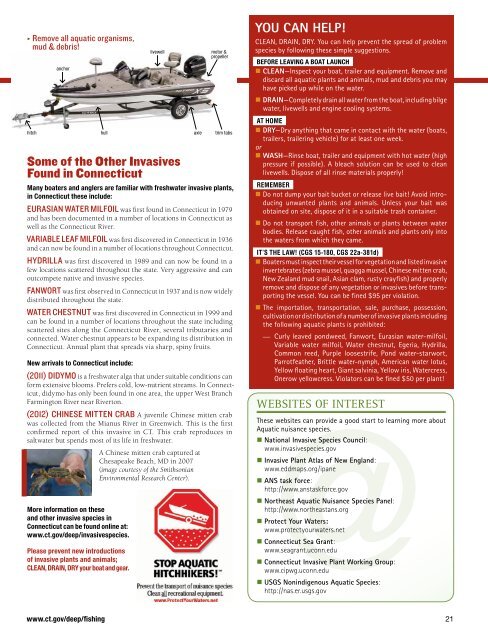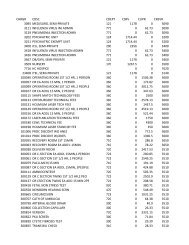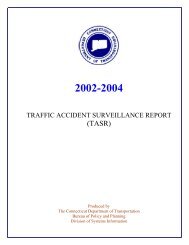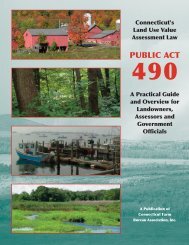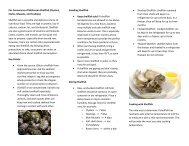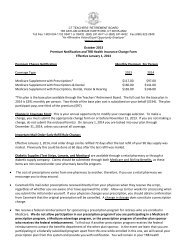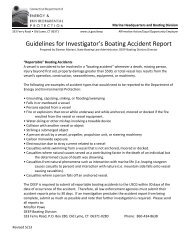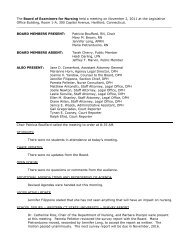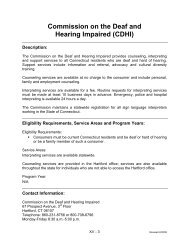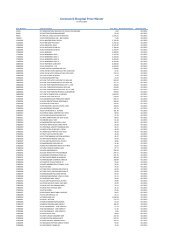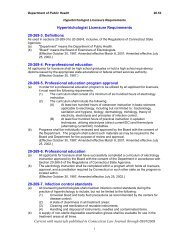2013 CT Anglers Guide - CT.gov
2013 CT Anglers Guide - CT.gov
2013 CT Anglers Guide - CT.gov
You also want an ePaper? Increase the reach of your titles
YUMPU automatically turns print PDFs into web optimized ePapers that Google loves.
≥≥Remove all aquatic organisms, ≥<br />
mud & debris!<br />
hitch<br />
anchor<br />
hull<br />
Some of the Other Invasives<br />
Found in Connecticut<br />
Many boaters and anglers are familiar with freshwater invasive plants,<br />
in Connecticut these include:<br />
Eurasian water milfoil was first found in Connecticut in 1979<br />
and has been documented in a number of locations in Connecticut as<br />
well as the Connecticut River.<br />
Variable Leaf Milfoil was first discovered in Connecticut in 1936<br />
and can now be found in a number of locations throughout Connecticut.<br />
Hydrilla was first discovered in 1989 and can now be found in a<br />
few locations scattered throughout the state. Very aggressive and can<br />
outcompete native and invasive species.<br />
Fanwort was first observed in Connecticut in 1937 and is now widely<br />
distributed throughout the state.<br />
Water chestnut was first discovered in Connecticut in 1999 and<br />
can be found in a number of locations throughout the state including<br />
scattered sites along the Connecticut River, several tributaries and<br />
connected. Water chestnut appears to be expanding its distribution in<br />
Connecticut. Annual plant that spreads via sharp, spiny fruits.<br />
New arrivals to Connecticut include:<br />
(2011) DIDYMO is a freshwater alga that under suitable conditions can<br />
form extensive blooms. Prefers cold, low-nutrient streams. In Connecticut,<br />
didymo has only been found in one area, the upper West Branch<br />
Farmington River near Riverton.<br />
(2012) Chinese mitten crab A juvenile Chinese mitten crab<br />
was collected from the Mianus River in Greenwich. This is the first<br />
confirmed report of this invasive in <strong>CT</strong>. This crab reproduces in<br />
saltwater but spends most of its life in freshwater.<br />
More information on these<br />
and other invasive species in<br />
Connecticut can be found online at:<br />
www.ct.<strong>gov</strong>/deep/invasivespecies.<br />
Please prevent new introductions<br />
of invasive plants and animals;<br />
CLEAN, DRAIN, DRY your boat and gear.<br />
livewell<br />
axle<br />
A Chinese mitten crab captured at<br />
Chesapeake Beach, MD in 2007<br />
(image courtesy of the Smithsonian<br />
Environmental Research Center).<br />
motor &<br />
propeller<br />
trim tabs<br />
You Can Help!<br />
CLEAN, DRAIN, DRY. You can help prevent the spread of problem<br />
species by following these simple suggestions.<br />
Before leaving a boat launch<br />
• CLEAN—Inspect your boat, trailer and equipment. Remove and<br />
discard all aquatic plants and animals, mud and debris you may<br />
have picked up while on the water.<br />
• DRAIN—Completely drain all water from the boat, including bilge<br />
water, livewells and engine cooling systems.<br />
At home<br />
• DRY—Dry anything that came in contact with the water (boats,<br />
trailers, trailering vehicle) for at least one week.<br />
or<br />
• WASH—Rinse boat, trailer and equipment with hot water (high<br />
pressure if possible). A bleach solution can be used to clean<br />
livewells. Dispose of all rinse materials properly!<br />
Remember<br />
• Do not dump your bait bucket or release live bait! Avoid introducing<br />
unwanted plants and animals. Unless your bait was<br />
obtained on site, dispose of it in a suitable trash container.<br />
• Do not transport fish, other animals or plants between water<br />
bodies. Release caught fish, other animals and plants only into<br />
the waters from which they came.<br />
IT’S THE LAW! (CGS 15-180, CGS 22a-381d)<br />
• Boaters must inspect their vessel for vegetation and listed invasive<br />
invertebrates (zebra mussel, quagga mussel, Chinese mitten crab,<br />
New Zealand mud snail, Asian clam, rusty crayfish) and properly<br />
remove and dispose of any vegetation or invasives before transporting<br />
the vessel. You can be fined $95 per violation.<br />
• The importation, transportation, sale, purchase, possession,<br />
cultivation or distribution of a number of invasive plants including<br />
the following aquatic plants is prohibited:<br />
——<br />
Curly leaved pondweed, Fanwort, Eurasian water-milfoil,<br />
Variable water milfoil, Water chestnut, Egeria, Hydrilla,<br />
Common reed, Purple loosestrife, Pond water-starwort,<br />
Parrotfeather, Brittle water-nymph, American water lotus,<br />
Yellow floating heart, Giant salvinia, Yellow iris, Watercress,<br />
Onerow yellowcress. Violators can be fined $50 per plant!<br />
WEBsites of interest<br />
These websites can provide a good start to learning more about<br />
Aquatic nuisance species.<br />
• National Invasive Species Council:<br />
www.invasivespecies.<strong>gov</strong><br />
• Invasive Plant Atlas of New England:<br />
www.eddmaps.org/ipane<br />
• ANS task force:<br />
http://www.anstaskforce.<strong>gov</strong><br />
• Northeast Aquatic Nuisance Species Panel:<br />
http://www.northeastans.org<br />
• Protect Your Waters:<br />
www.protectyourwaters.net<br />
• Connecticut Sea Grant:<br />
www.seagrant.uconn.edu<br />
• Connecticut Invasive Plant Working Group:<br />
www.cipwg.uconn.edu<br />
• USGS Nonindigenous Aquatic Species:<br />
http://nas.er.usgs.<strong>gov</strong><br />
www.ct.<strong>gov</strong>/deep/fishing 21


